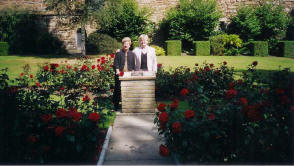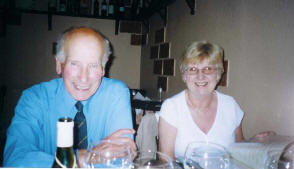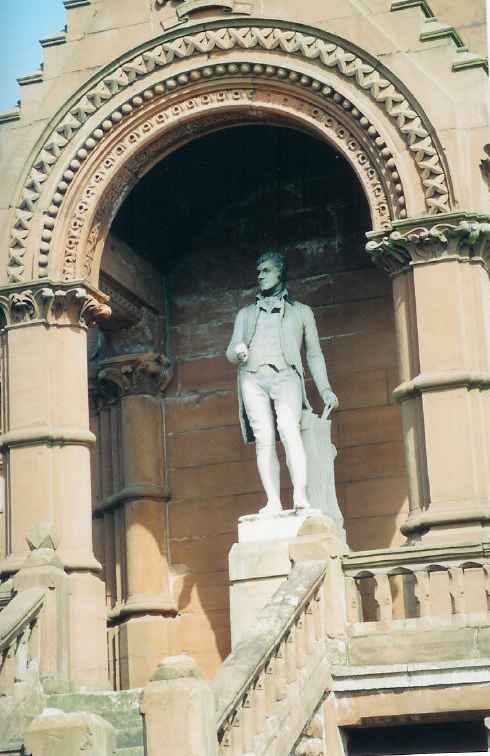Burns Chronicle and Club Directory
No. 1. 25th January 1892
Reviewed by Frank R. Shaw, FSA Scot, Atlanta, GA, USA
The vast
majority of our 70,000+ subscribers are not members of a local Burns
Club and may be unaware of an important publication aptly named the
Burns Chronicle. Allow me to introduce you to it. I
have enjoyed collecting these journals via eBay, from old Scottish
bookshops, and have even received several volumes from Burnsian
friends such as Thomas Keith of New York City and, most recently,
Dr. Ross Roy of the University of South Carolina. It is fascinating
to read and study these journals that now total 46 volumes in my wee
Burns library. Just today I ordered nine additional ones from an ad
in the Burns Chronicle by the Derby Scottish Association and Burns
Club, England. We all remember Derby as the “roundabout” who sent
the Jacobite Army hurrying back to Scotland with a sulking Bonnie
Prince Charlie being just a little over a hundred miles from his
perceived life-long destiny - London - to recapture the throne of
England for his father.
The
Robert Burns World Federation Limited recently made
available the first nine volumes (1892 - 1900) of the chronicle. No
publication, in my opinion, defines a club’s history as well as this
annual journal, published since 1892. I have seen it referenced many
times in books, articles, pamphlets, speeches and dissertations.
Yes, blue collars and scholars alike, once they discover the
journal, find it hard to let go.
In a break
from reviewing a current published book, it is my pleasure to review
the first chronicle dated 25 January 1892. For those of you unaware
of that date, it is the day and month of Robert Burns’ birthday that
is celebrated around the world with good food, good drink, good fun
and, sometimes, good speeches called “The Immortal Memory.”
Since it is a bit impossible to have a “chat” with the authors, that
usual column of ours will be omitted from this issue of The
Family Tree.
The 1892
Burns Chronicle begins, naturally enough, with a “Brief Summary
of the Life of Burns,” written evidently by the editor, one John
Muir, and is followed by a “Summary of the Posthumous History of
Burns”. To me, the life of Burns was more exciting that the
thousands of books written about him, and it is no less true of
these first two articles. I feel that many great writers, like
Hemingway for instance, led lives more interesting and complex than
their books ever came close to capturing in print. The same is true
for Burns. When you consider the one book he wrote, Poems
Chiefly in the Scottish Dialect, even though it can today
bring $60,000 for the Kilmarnock edition, it does not capture the
total life experiences of the man who left us all too soon. It is a
wonderful book of poetry, particularly if you speak Scottish. And,
even though it tells a lot about Burns, it certainly does not tell
us all there is to know about this marvelous human being. His poetry
has all the marks of exceptional greatness that has stood the test
of critical scrutiny since his birth in 1759. His poetry is
beautiful, smooth, comforting, humorous, sarcastic, manly, tender,
caring, loving, and frankly at times, hard to understand unless you
have a Scottish dictionary. Yet, his writings in poetry and song
exhibit a genius beyond his years.
In this
writer’s opinion, it is in his letters where one sees the total
Burns. Here he takes us through the prose of his life, a life rocked
continually with near poverty, very hard work, and the long-term
sickness that finally caught up with him in Dumfries where he died
as a 37-year-old man. In his letters we find all of Burns, warts and
all. Again, his life, like that of Hemingway, can be said to be one
of constant emotions in conflict. His life was extremely hard but
full of love, if not money. Those who knew him best loved him most.
Those who knew him least were very critical of him. That should tell
you something. He loved his fellow man until they crossed a line.
Then, with pen in hand, he could cut them to ribbons with wicked
sarcasm. Burns’ love of books was second to none, yet he only wrote
one volume. Robert Burns was a man’s man. Yet, like most of us, he
would turn most quickly from a position he advocated if he thought
it would cost him his job and crush his family financially. Like any
dirt farmer, he lived by the sweat of his brow.
Allow me to
digress at this point. I like to use the phrase “dirt farmer”
because my father, as a young married man, experienced some of the
same hardships in his early years, as did Burns. I’ve heard that Dad
lost what was called a “sixteen horse farm” back then when the Great
Depression came along. Sounds very familiar to Burns and his own
farming attempts in his part of Scotland. My dad never went back to
farming and neither did Burns. My dad pulled up stakes and moved
form North Carolina to South Carolina for a new beginning. Burns did
the same. Yet, Charlie Shaw carried with him over the years a
stooped back from his early farming days even though he lived nearly
twice as long as Burns. It is difficult not to make comparisons when
you reflect on the two men as to farming.
I had a
“brief encounter of a close kind” with farming. During one summer, I
worked on a farm in Horry County, SC that belonged to my beloved
sister, Peggy, and her husband, Fred, a most honorable and loving
man. I very vividly recall putting in tobacco. I learned what to do
around the barn to help out, and I learned to drive the “drag”
behind the mule to bring tobacco from the field to the barn. I would
“hand’ tobacco, but I was never allowed to “string” tobacco, that
took a special talent. The work was hard. Plowing cornfields with a
mule and plow where the view is always the same is not all that
exciting!
Farm life
really makes you appreciate sundown but dread sunrise. The hours
were long, but the home cooked meals were wonderful and the sweet
bread we enjoyed in the afternoons instead of store bought cookies
was a treat. But I learned that there were too many things farmers
could not control - crop failure, low prices, and all to often, too
little rain, and every now and then, too much rain. No wonder
farmers go to church and pray at mealtime and before going to bed at
night. I did not learn all there is to know about farming or
plowing, or crops or cows, or killing hogs for fresh pork, but I’ll
never forget the smile of joy on my mother’s face after I was paid
$63 for my work at the end of that summer and when I handed it all
to her to help with the bills at home. It was the most money I had
ever seen in my short lifetime. Like in the Burns home, money was
scarce in those days. But I did learn as a lad of 13 and 14 enough
to know that I would find another way to make a living! Later, when
my parents passed away three months apart in Mullins, SC, Fred and
Peggy took me in to live in their home in North Charleston and,
greater still, took me into their bosom. Yes, Fred had given up on
farming, too!
Now, back to the Burns Chronicle.
The first journal continues with an article on his influence on
American literature, a brief memoir of “Bonnie Jean”, the topography
of Kilmarnock, interesting chapters on the portraits of Burns, his
music, and a brief note on the Burns Federation, which proclaims the
journal as “the only publication wholly devoted to the interest of
Burns students”, which no one can dispute.
As a side
bar, I get a kick out of some of the 1893 advertisements that helped
offset the journal costs. Oddly, there were none in the first
edition, but in the second one there is an advertisement for H.
Lauder & Co., “The Emporium” which proudly states, “Marriage and
Mourning Orders Punctually Attended To”. Then there is “The Best
Edition of ‘Burns Works’ Offered Cheap” - not inexpensive or a good
bargain or a good buy but “cheap”. Scots will be Scots! Even then
the reputation of Burns was worldwide as “Poesie Di Robert
Burns” is advertised with this explanation: “First attempted
Translation of Burns into Italian” by Signor Ulisse Ortensi. Note
the word “attempted” - hey, either it’s in Italian or not.
There is Dr. Thompson, a dispensing chemist which is similar to our
pharmacist, whose ad states, “Nervetonine is a positive cure
for all Nervous Affections, Nervous Exhaustion, Nervous Debilitry,
Loss of Nerve and Brain Power, Hysteria, Loss of Memory,
Sleeplessness, Paralysis,” and the beat goes on, but ends by
claiming all of the above and the other dozen maladies that I did
not mention are “…permanently cured with Nervetonine.” Send
me a truckload! Yet my favorite one is from Shaw, Walker & Co. that
unapologetically states that they were “Established to supply the
public with Goods, at the smallest possible profit.” (Italics
mine.) Yeah, right! And to think a Shaw said that!
I am very grateful to Peter
Westwood, Editor of the Burns Chronicle, and
the Burns Federation for making these nine volumes available. Mr.
Westwood is editor of The Deltiology of Robert Burns,
a most unusual book about the life and work of Robert Burns as told
through the media of illustrated postcards. He also edited
Jean Armour, My Life and Times with Robert Burns. He is soon
to publish the Definitive Illustrated Companion to Robert Burns, six
volumes and over 4,000 pages, which many Burnsians look forward to
buying. I have only been a member of the Federation since February
2002 and attended my first local Burns Club meeting just three years
ago for their Christmas outing. Yet, I have quickly come to really
enjoy the benefits of membership in both. I wish I had known about
the Burns Club and the Burns Federation much earlier, but one plays
the hand life has deals you. The journal, which now comes out three
times a year, is a welcomed arrival at my home.
If you are fortunate enough to
have a local Burns Club, let me encourage you to join. Your life
will take on an added dimension as you learn about Burns and enjoy
the fellowship of some wonderful people. The warmth of friendship is
ever present and never surpassed. No one enjoys his Burns Club
membership more than I do. Susan and I look forward to our monthly
meetings. The programs are not just on Burns but are varied since my
Burns Club bills itself as a literary club, not a Scottish or
exclusive Burns Club. Nevertheless, it is the membership that makes
a club worthwhile. Our local club members are exceptionally friendly
and, trust me, they know their Burns.
Internationally, check out the Federation. Shirley Bell is a very
talented Chief Executive, and Margaret Craig, Office Administrator,
ably assists her. Ten minutes after you meet these two, you feel
like you have known them forever. You do not have to be a member of
a local Burns Club to join the Robert Burns World Federation. If you
have any interest in joining, contact them at Robert Burns World
Federation Limited, Dean Castle Country Park, Dower House,
Kilmarnock KA3 1XB, Scotland. You may phone or fax the office at
011-44-1563- 572469. Email:
robertburnsfederation@kilmarnock26.freeserve.co.uk.
(11-12-03)

L-R: Susan Shaw and Shirley Bell at
Dean Castle in Kilmarnock by the Memorial Cairn honoring victims of
the 9/11 attacks on the World Trade Center.

Dean Castle, home of the Robert Burns
World Federation office. The roses in the background are named
after Robert Burns and the ones in front after Jean Armour.

Jack and Shirley Bell of Dumfries

Statue of Robert Burns in the Kilmarnock
monument |

